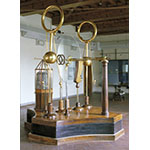-
Setting:Room XI
-
Inventor:Carl Winter
-
Maker:Museo di fisica workshops
-
Date:second half 19th cent.
-
Materials:mahogany and other woods, brass, iron, glass, tin foil, gold foil
-
Dimensions:total height 2600 mm, base (max. dimensions) 2460x2255 mm, disk diameter 1215 mm, thickness 6 mm
-
Inventory:1526
-
This is the largest generator of its kind still in existence, and the final development of plate frictional electrical machines. The glass plate has a composite axle of glass and brass. It is supported on the brass side by two glass pillars, and on the glass side by a stout wooden one. In this way, strength of construction is combined with efficient insulation. The plate is rubbed by two cushions in a mahogany frame supported on a glass stem. The most noteworthy construction feature is the two large "inductor" rings coated in gold foil and insulated on glass supports on either side of the machine. One of these acts as the "negative" conductor when connected to the cushions. The other is the prime or "positive" conductor, the glass plate rotating between its ring-shaped collectors. At the front is a brass sphere on an insulated support (replacement). At the back are two discharging conductors, one on a clear glass support, the other on a green glass support. At the prime-conductor side is a very large Leyden jar, protected in an eight-sided glass and wood case. Two long wooden rods, terminating in hooks and coated in gold foil, are suspended from the rings that were probably used to connect the various parts of the machine together. The machine has been heavily restored.
Carl Winter devised this generator type in the mid-eighteenth century. It is essentially a descendant of Jean Baptiste Le Roy's "long spark" machine of 1772. The capacity of this design was augmented by Winter's "inductor" rings, which contained one or more coils of thick iron wire. Provenance: Lorraine collections.









